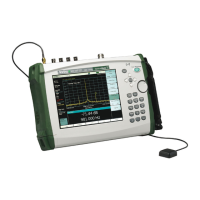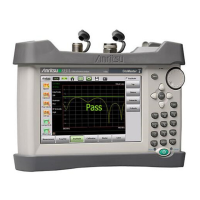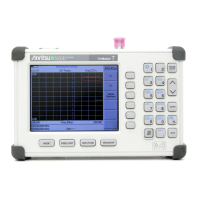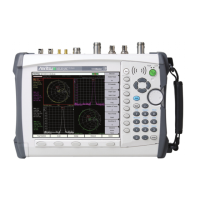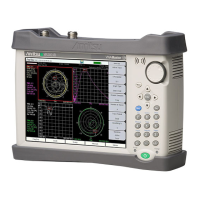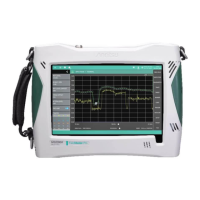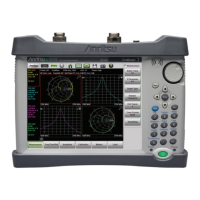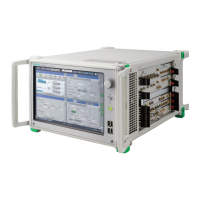2-2 Spectrum Analyzer Function Verification Performance Verification 1
2-26 PN: 10580-00177 Rev. D MS2721B MM
6. Set the RBW to 1 kHz.
7. Press the Amplitude function hard key and set the Reference Level to 10 dBm.
8. Set the Attenuation Level to 30 dB.
9. Adjust the MG3692x power level so that the power meter reading for Sensor B matches the Sensor B
value that is shown in Table A-19, “Characterization Chart for 50 MHz Amplitude Accuracy
Verification” on page A-7.
10. Press the Marker key, and press the Peak Search soft key.
11. Record the Marker 1 amplitude reading to Table A-20, “50 MHz Amplitude Accuracy Verification”
on page A-7.
12. Repeat Step 9 through Step 11 for the other power levels in Table A-20, changing Reference Level and
Attenuation Level settings as required.
Amplitude Accuracy Across Frequency Verification
Component Characterization:
1. Connect both MA2442D power sensors to the power meter and calibrate the sensors.
2. Connect the equipment as shown in Figure 2-9.
3. Set the MG3692x Frequency to 10.1 MHz.
4. Set the power meter to display both Channel A and Channel B. Press the Sensor key, the Cal Factor soft
key, and then the Freq soft key. Use the keypad to enter the value matching the frequency of MG3692x
as the input signal frequency, which sets the power meter to the proper power sensor calibration factor.
Repeat for Channel B. Press the System key to display the power reading.
5. Adjust the MG3692x output level so that the Sensor A reading is –2 dBm ± 0.1 dB.
6. Record the Sensor B reading into the –2 dBm column in Table A-21, “Characterization Chart for Fixed
Level with Varying Frequency, Amplitude Accuracy” on page A-8.
7. Adjust the MG3692x output level so that the Sensor A reading is –30 dBm ± 0.1 dB.
8. Record the Sensor B reading to the –30 dBm column in Table A-21.
9. Repeat Step 3 through Step 8 for all of the frequencies that are listed in Table A-21.
Procedure:
1. Connect the equipment as shown in Figure 2-10.
2. Set the MS2721B to Spectrum Analyzer mode and then preset the instrument.
3. Press the BW function hard key. Then set the RBW to 1 kHz and the VBW to 10 Hz.
4. Press the Span soft key, set span to 10 kHz.
5. Set the MG3692x frequency to 10.1 MHz CW.
6. Set the MG3692x Output to –20 dBm.
7. Set the power meter to display Channel B. Press the Sensor key, the Cal Factor soft key, and then the
Freq soft key. Use the keypad to enter the value matching the frequency of MG3692x as the input signal
frequency, which sets the power meter to the proper power sensor calibration factor. Press the System
key to display the power reading.
Caution
To maintain test setup integrity, do not disconnect Sensor B, the power splitter, or the fixed
attenuator.
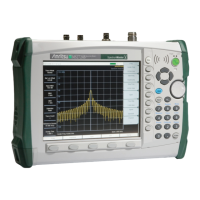
